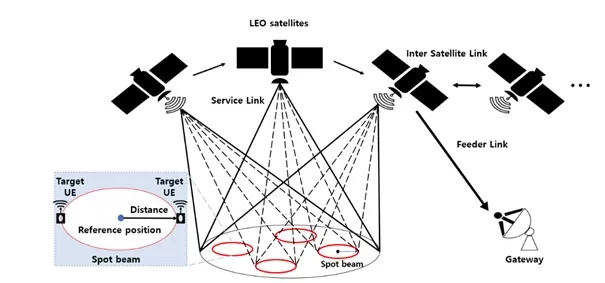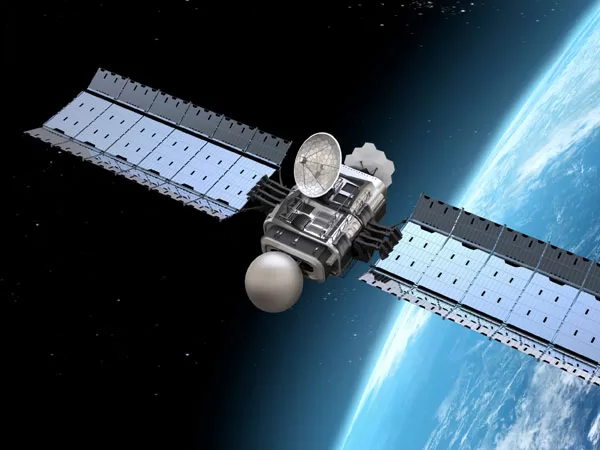Abstract
The 3GPP Release 17 aims to extend NB-IoT’s reach further by exploring its compatibility with non-terrestrial networks (NTNs).
In this article, we will explore NB-IoT over NTN, introduced in Release 17, an overview of the architecture and the technical. We also discuss potential solutions to these challenges and future directions for this technology.
System Architecture for NB-IoT over NTN
The integration of NB-IoT into Non-Terrestrial Networks (NTN), as outlined in 3GPP Release 17, involves a key system architecture. This includes a satellite in low Earth orbit (LEO) equipped with a regenerative payload. This means the satellite can perform all or some functions of a traditional base station (gNB).
The system architecture can also accommodate satellites in Geostationary Orbit (GEO). These satellites, similar to their LEO counterparts, can be equipped with regenerative payloads.
| Platforms | Altitude range | Orbit | Typical beam footprint size |
| Low-Earth Orbit (LEO) satellite | 300 – 1500 km | Circular around the earth | 100 – 1000 km |
| Geostationary Earth Orbit (GEO) satellite | 35 786 km | notional station keeping position fixed in terms of elevation/azimuth with respect to a given earth point | 200 – 3500 km |
Figure 1: Typical NTN Platforms
The satellite generates several spot-beams over its coverage area to increase its capacity. These spot-beams move along with the satellite, and each spot-beam size depends on the elevation angle and the satellite configuration.

Figure 2: NB-IoT over NTN
The Physical Layer
NB-IoT supports LTE frequency bands from 450 to 2690 MHz, both in frequency division duplex (FDD) and time division duplex (TDD) modes. To minimize design impact, it’s beneficial to limit Non-Terrestrial Network (NTN) support to the existing LTE frequency range, up to roughly 6 GHz, prioritizing FDD bands due to the challenges of supporting TDD in NTNs with large Round Trip Times (RTTs).
In NTNs, timing is crucial due to larger spotbeam radius and device-Base Station (BS) link distances, compared to the typical 120 km cell radius in terrestrial NB-IoT. This affects time/frequency adjustment mechanisms like Timing Advance (TA) and Uplink (UL) frequency compensation indication.
Global Navigation Satellite System (GNSS)-aided solutions can address these issues. For example, a GNSS-equipped device can estimate and pre-compensate the RTT before random access, leaving the BS receiver to handle only a small residual timing error.
Higher Layer Procedures
For power-efficient operation of many NB-IoT devices, accurate cell selection and reselection are crucial, based on estimated service link propagation delay and geographical distance. The network’s maximum Round Trip Time (RTT) and Signal-to-Noise Ratio (SNR) are key considerations.
Timers in the MAC, RLC, PDCP, and RRC layers, already dimensioned for extended coverage, need minimal adjustment for high RTT. Three timers need optimization for Non-Terrestrial Networks (NTN): MAC Contention Resolution timer, MAC hybrid automatic repeat request (HARQ) RTT timer, and RLC t-reordering timer.
NB-IoT supports two HARQ processes, but increasing this number isn’t viable due to increased receiver complexity. An enhancement would be to disable HARQ and let RLC automatic repeat request (ARQ) manage retransmissions.
Finally, the RRC layer broadcast signaling needs to be updated with NTN-specific information, including satellite locations, maximum RTT, and geographical center point of each cell.
Top of Form
Benefits of NB-IoT over Non-Terrestrial Networks
The integration of NB-IoT into Non-Terrestrial Networks brings a host of benefits that extend beyond the traditional use cases of satellite and terrestrial networks. This integration is set to revolutionize the way we communicate, especially in remote and hard-to-reach areas.
- Better Coverage and Connectivity
One of the most significant advantages of NB-IoT over NTN is the ability to provide a better coverage. This technology can reach remote, sparsely populated areas of the world where the deployment of terrestrial networks has been prohibitively expensive. It can also cover challenging user locations such as airplanes, ocean-going ships, and long-distance train routes. As a result, NB-IoT over NTN can deliver truly global connectivity, bridging the gap between terrestrial and satellite communications.
- Support for a Wide Range of Applications
NB-IoT over NTN is not limited to IoT applications. Recent developments indicate that NB-IoT can also support other features such as texting, voice communication, and multicast firmware updates. This versatility opens up a wide range of potential applications, from emergency services in remote areas to automatic software updates for cars and offshore wind farms.
- Long Battery Life for Connected Devices
NB-IoT is a low-power technology, which means it can support connected devices with a battery life of up to ten years. This feature is particularly beneficial for IoT applications, where devices may need to operate for extended periods without access to a power source.
- Global Availability
The integration of 5G NB-IoT with the 3GPP standard ensures that the technology will be available worldwide. NB-IoT (and LTE-M) are the only standards that 3GPP plans to support for Low Power Wide Area (LPWA) use cases, making them a globally accepted solution for IoT applications.
- Enabling New and Innovative Solutions
The power and flexibility of future NB-IoT networks will lead to the deployment of new, innovative solutions that were previously unsupportable or even unimagined. Whether it’s for emergency services, mission-critical situations, or simple sensor surveillance, NB-IoT over NTN can establish automatic or manual push-to-talk communication channels, creating new user experiences.
Performance Analysis
One of the critical aspects to consider when integrating NB-IoT into Non-Terrestrial Networks (NTN) is the link budget analysis.
The link budget analysis for NB-IoT over NTN involves several factors. The power of the transmitted signal, the gain and loss in the antennas, the loss in the signal due to propagation (especially important in NTN where the signal may have to travel a large distance through space), and the sensitivity of the receiver are all crucial considerations.
The power of the transmitted signal is a critical factor. In NB-IoT over NTN, the signal may have to travel a large distance through space, which can lead to significant propagation loss. Therefore, the transmitter must be powerful enough to ensure that the signal can reach the receiver with sufficient strength.
Antenna gains can help to compensate for some of the signal loss. High-gain antennas can focus the signal more narrowly, which can increase the signal strength in the direction of the receiver. However, antenna losses, such as those due to impedance mismatch, must also be considered.
The sensitivity of the receiver is another important factor. The receiver must be sensitive enough to detect the signal, even if the signal strength has been significantly reduced due to propagation loss and other factors.
This analysis is crucial for assessing the feasibility and performance of NB-IoT over NTN. But how do we measure its performance?
Let’s consider a hypothetical scenario where we want to calculate the link budget for an NB-IoT over NTN system.
For this simulation, we’ll use the Link Budget Calculator available on the everything RF website.
Here are the steps:
- Transmitted Power (PTX): This is the power output from the transmitter. For our simulation, let’s assume it’s 23 dBm.
- Transmitter Gain (GTX): This is the gain of the transmitter antenna. Let’s assume it’s 14 dBi.
- Transmitter Losses (LTX): These are the losses in the transmitter system. Let’s assume it’s 2 dB.
- Free Space Path Loss (LFS): This is the loss of power that occurs when the signal travels through free space. This value is dependent on the distance and frequency. For our simulation, let’s assume it’s 148 dB.
- Miscellaneous Losses (LM): These are other losses that might occur in the system. Let’s assume it’s 3 dB.
- Receiver Gain (GRX): This is the gain of the receiver antenna. Let’s assume it’s 14 dBi.
- Receiver Losses (LRX): These are the losses in the receiver system. Let’s assume it’s 2 dB.
After inputting these values into the calculator, the Received Power (PRX) calculated is -104 dBm.
A received power of -104 dBm is quite low, which is typical for many low-power IoT applications like NB-IoT.
In practical terms, this means that the signal is weak when it reaches the receiver. However, NB-IoT is designed to work with such low signal strengths. It uses advanced signal processing techniques to extract the transmitted information from these weak signals.
The key point here is that even though the signal is weak, as long as it is above the sensitivity threshold of the receiver (the minimum signal strength the receiver needs to correctly decode the signal), communication can occur. For NB-IoT, this sensitivity threshold is typically around -130 dBm to -140 dBm, so a received power of -104 dBm would be sufficient for successful communication.
Challenges and Technical requirements
To ensure the successful implementation of IoT, specific technical requirements must be met. These requirements include:
- Path Loss & Doppler offset:
The height causes a high path loss and a large RTT. The mobility of an LEO satellite introduces a very high Doppler offset on the radio link, and it also inevitably requires all devices to frequently change their serving nodes.
- Higher frequency equals greater signalling challenges:
The NB-IoT NTN will begin operating on S-band frequencies which range between 2-4 gigahertz (GHz), crossing the conventional ultra-high frequency (UHF) and super high frequency (SHF) band. However, higher frequencies might affect satellite-connected 5G service quality, efficiency, and reliability worldwide. Discussions are ongoing between 3GPP and the ITU to address frequency spectrum challenges and how they affect NB-IoT connectivity.
- Security:
With the increased number of connected devices, IoT networks are vulnerable to cyber-attacks. Therefore, security measures such as authentication, encryption, and firewalls must be implemented to protect against data breaches.
- Interoperability:
IoT devices must be able to communicate with each other, regardless of the manufacturer or technology used. Standardization is essential to ensure interoperability.
- Cost:
For applications that require low-cost communication, NB-IoT may be the best option. However, in remote areas where cellular coverage is limited or nonexistent, satellite communication may be the only viable option, despite its higher cost.
- Power Consumption:
For battery-powered devices, NB-IoT is a better option than satellite communication because it can operate on low power consumption. In contrast, satellite communication requires higher power consumption for transmission, which can limit the lifespan of battery-powered devices.
- Data management:
IoT devices generate vast amounts of data that must be collected, analyzed, and stored. This requires data management systems capable of handling big data.
3GPP Recommendations for NTN Integration
The 3GPP has laid out specific recommendations for integrating satellites into the 5G system. These recommendations are crucial for the successful implementation of NB-IoT over NTN.
The 3GPP recommendations are based on the type of user equipment (UE) in the NTN system. For UEs with Global Navigation Satellite System (GNSS) capabilities, the UE performs the pre-compensation of Doppler shift and delay propagation. This is possible thanks to the knowledge of satellite ephemeris and available UE location.
For UEs without GNSS capabilities, the satellite performs the pre-compensation of Doppler shift at the center of the beam on the ground and broadcasts the common delay to all UEs inside the concerned beam to be considered for the uplink transmission.
These recommendations are vital for the seamless integration of NB-IoT into NTN, ensuring that the system can handle the unique challenges posed by satellite constraints such as larger propagation delays and stronger Doppler effects.
Conclusion
In conclusion, integrating NB-IoT into Non-Terrestrial Networks (NTN) offers promising advancements for IoT connectivity. This integration brings improved coverage, versatility, extended battery life, global availability, and the potential for innovative solutions. Despite the technical complexities and challenges such as path loss, Doppler offset, security, interoperability, cost, and data management, the guidelines provided by 3GPP offer a robust framework to address these issues. As research and development continue, NB-IoT over NTN holds immense potential to revolutionize global connectivity.
References
- Document TR 36.763, Release 17, 3GPP, May. 2021
- Narrowband Internet of Things for Non-Terrestrial Networks,” in IEEE Communications Standards Magazine, vol. 4, issue. 4, pp. 49-55, December 2020
- https://www.everythingrf.com/rf-calculators/link-budget-calculator

